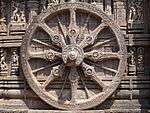Historic sites in Odisha
This article lists monuments and sites of historic importance in Odisha, India.
| This article is part of a series on |
| Odisha |
|---|
 |
| Governance |
|
| Topics |
| GI Products |
|
|
Districts Divisions |
|
|
Prehistoric
| Site | Date(s) | Picture | Location | Description | References |
|---|---|---|---|---|---|
| Gudahandi | c. 20000 BCE | Kalahandi district | Rock paintings from upper paleolithic. | ||
| Vikramkhol | c.3000 BCE | Jharsuguda | Prehistoric human rock shelter with inscriptions. | [1] |
Ancient
Singhapura (In Jajpur Dist): Some historians say it was the capital of Singha Bahu, a Kalinga King who was contemporary of Lord Buddh and Bimbisar of Rajgrih. His exiled son Prince Vijaya established Sinhalese dynasty in Sri Lanka. The Archaeological Survey of India has been requested to excavate this site to unravel the truth.
| Site | Date(s) | Picture | Location | Description | References |
|---|---|---|---|---|---|
| Dhauli | 262 BCE |  |
Dhauli, Bhubaneswar | Site of the Kalinga War | [2] |
| Sisupalgarh | c.300 CE | 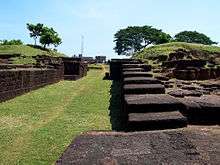 |
Bhubaneswar 20°13′35.9″N 85°51′11.0″E |
Ancient fort | [3] |
| Asurgarh | c.6th century CE | Kalahandi | Ancient fort with a moat and surviving ramparts of 9 metres. | [4] | |
| Bindusagar Tank | c. 7-8th century CE | 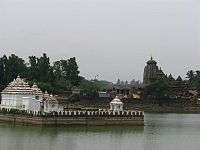 |
Old Town, Bhubaneswar | A ritual tank with a shrine in the centre. | [5] |
| Chausath Yogini Temples | c. 9th century CE | 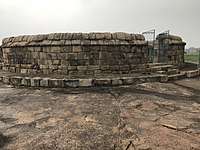 |
Jharial, Bolangir | A group of 64 yogini temples. | [6] |
| Chausathi Jogini Temple | 9th century CE | Hirapur, Khurda | Hypaethral temple for 64 Yoginis in the outskirts of Bhubaneswar | [7] | |
| Anantashayana Vishnu | 9th century CE |  |
Sarang, Dhenkanal | 15 metre long rock cut image of Vishnu lying in rest. | [8] |
Medieval
| Site | Date(s) | Picture | Location | Description | References |
|---|---|---|---|---|---|
| Ratnagiri | c.10th century | Jajpur | Buddhist monastery built by the Bhauma-Kara dynasty | [9] | |
| Lalitgiri | c.10th century | Cuttack | A group Buddhist monasteries. | [10] | |
| Brahmeswara Temple | 1058 CE | Bhubaneswar | Shiva temple built during reign of the Somavamsis | [11] | |
| Jagannath Temple | c.1090 | 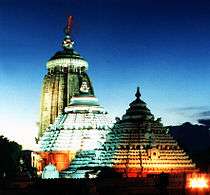 |
Puri | Vaishnava temple built by Eastern Ganga dynasty kings. | [12] |
| Lingaraja Temple | c.1100 | Bhubaneswar | Shiva temple built by Somavamsi kings. | [13] | |
| Gundicha Temple | 12th century |  |
Puri | Built by the Eastern Ganga dynasty. Houses the main idols during the Ratha Yatra festival. | [14][15] |
| Barabati fort | c. 1230 | Cuttack | Presumed to have been built by Anangabhimadev III of the Eastern Ganga dynasty | [16] | |
| Kapilash Temple | 1246 |  |
Dhenkanal | Shiva temple constructed by Narasingha Deva I. | [17] |
| Konark Sun Temple | c. 1250 |  |
Konark | Supposedly built by king Narasingha Deva I of Eastern Ganga Dynasty around 1250. | [18] |
| Ananta Vasudeva Temple | c.1278 | 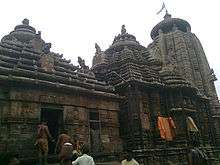 |
Bhubaneswar | Vaishnava temple built by Queen Chandrika, daughter of Anangabhimadeva III, of the Eastern Ganga dynasty | [12][19] |
| Atharanala Bridge | c.1300 | Puri 19°49′11″N 85°49′54.1″E |
Bridge with 18 arches, purportedly built by Narasingha Deva II of Eastern Ganga Dynasty. | [20] | |
| Biraja Temple, Jajpur | 13th Century | Built originally by Jajati Keshari of Soma Dynasty | |||
| Annakoteshvara Temple | 16th Century | Latadeipur, Gondia, Dhenkanal | Shiva temple built during the reign of the Gajapati dynasty | [21][22] | |
| Alarnath Temple | 1610 AD | Brahmagiri, Puri, 752011 | [23] | ||
| Baladevjew Temple | 1707 | Kendrapara | Temple built during Maratha occupation of Orissa. | [24] | |
| Qadam-e-Rasool | 1718 | Cuttack | Mosque built by Shuja-ud-Din Muhammad Khan. Purportedly contains a Qadam Rasul (footprint of the Prophet Muhammad). | [25] |
Colonial
| Site | Date(s) | Picture | Location | Description | References |
|---|---|---|---|---|---|
| Joranda Gadi | Early 20th century | 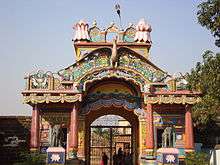 |
Joranda, Dhenkanal | Contains the samadhi of the founder of the Mahima Dharma sect. | [26] |
| Inchudi | 1930 | Balasore | Site of Salt Satyagraha in the state. | [27] |
gollark: It was in direct response to> you're the rediculous one here boyo
gollark: No.
gollark: Yes.
gollark: Says you, a person named Tux1.
gollark: Last time I mathematically proved this sort of thing you just denied it. Apioform you.
See also
References
- "Ancient rock art starts to fade out: Engravings in Vikramkhol cave under threat". The Telegraph (India). 27 December 2011. Retrieved 10 June 2014.
- Subodh Kapoor (2002). Indian Encyclopaedia. Cosmo Publications. p. 1137. ISBN 978-81-7755-257-7. Retrieved 8 August 2014.
- Paul Yule. Early Historic Sites in Orissa (Delhi 2006) 19-22.
- Amalananda Ghosh. An Encyclopaedia of Indian Archaeology. BRILL. p. 25. ISBN 90-04-09264-1. Retrieved 10 June 2014.
- "Bindusagar Tank" (PDF). Indira Gandhi National Centre for the Arts (IGNCA). Indira Gandhi National Centre for the Arts (IGNCA). Retrieved 8 August 2014.
- "Ranipur-Jharial Yogini Temple: A Ninth Century Monument Remains in Ruins". The New Indian Express. 7 March 2014. Archived from the original on 10 June 2014. Retrieved 10 June 2014.
- "Yogini temple of Hirapur". The Hindu. 17 October 2003.
- "Anantasayana Visnu" (PDF). Indira Gandhi National Centre for the Arts (IGNCA). Indira Gandhi National Centre for the Arts (IGNCA). Retrieved 8 August 2014.
- "Excavated Buddhist site, Ratnagiri". Archaeological Survey of India. Archaeological Survey of India. Retrieved 10 June 2014.
- "Excavated Buddhist site, Lalitgiri". Archaeological Survey of India. Archaeological Survey of India. Archived from the original on 26 September 2014. Retrieved 10 June 2014.
- "Brahmeswara Temple" (PDF). Indira Gandhi National Centre for the Arts (IGNCA). Indira Gandhi National Centre for the Arts (IGNCA). Retrieved 8 August 2014.
- Prabhat Mukherjee (1981). The History of Medieval Vaishnavism in Orissa. Asian Educational Services. pp. 29–, 32. ISBN 978-81-206-0229-8.
- Pabitra Mohana Nāẏaka (2011). Inscriptions of Orissa: With Special Reference to Subarnapur. Readworthy. p. vii. ISBN 978-93-5018-042-6. Retrieved 10 June 2014.
- "Gundicha Temple" (PDF). Indira Gandhi National Centre for the Arts (IGNCA). Indira Gandhi National Centre for the Arts (IGNCA). Retrieved 8 August 2014.
- "Five Lakh Throng Gundicha Temple in Puri". The New Indian Express. 7 July 2014. Retrieved 8 August 2014.
- Hemanta K. Mohapatra (January 2004). "Remembering the Great Barabati Fort" (PDF). Orissa Review. Government of Odisha. Retrieved 10 June 2014.
- "Kapilash Temple". District Portal: Dhenkanal. Government of Odisha. Retrieved 10 June 2014.
- Indian History. Tata McGraw-Hill Education. p. B3. ISBN 978-0-07-132923-1. Retrieved 8 August 2014.
- Trilochan Dash. Story of Lord Sri Jagannatha in Srimandira at Sri Purusottam Kshetra. Trilochan Dash. p. 31. GGKEY:Y2TR84PZ0DD. Retrieved 10 June 2014.
- O. M. Starza (1993). The Jagannatha Temple at Puri: Its Architecture, Art, and Cult. BRILL. p. 8. ISBN 90-04-09673-6. Retrieved 10 June 2014.
- "Alphabetical List of Monuments - Orissa". Archaeological Survey of India (ASI). Archaeological Survey of India (ASI). Retrieved 8 August 2014.
- "Annakotesvara Temple" (PDF). Indira Gandhi National Centre For The Arts (IGNCA). Indira Gandhi National Centre For The Arts (IGNCA). Retrieved 8 August 2014.
- "alarnath temple - Google Search". www.google.com. Retrieved 21 July 2020.
- "30 lakhs were granted for the renovation of Baldevjew and Mausi Maa temples under heritage conservation project". The Indian Express. 9 June 2014. Retrieved 15 June 2014.
- Mohammed Yamin (May 2011). "Islamic Monuments in Cuttack" (PDF). Orissa Review. Government of Odisha. Retrieved 10 June 2014.
- "Joranda Gadi" (PDF). Indira Gandhi National Centre for the Arts (IGNCA). Indira Gandhi National Centre for the Arts (IGNCA). Retrieved 8 August 2014.
- "Satyagraha memory fades with time". The Telegraph (India). 12 September 2012. Retrieved 10 June 2014.
This article is issued from Wikipedia. The text is licensed under Creative Commons - Attribution - Sharealike. Additional terms may apply for the media files.
